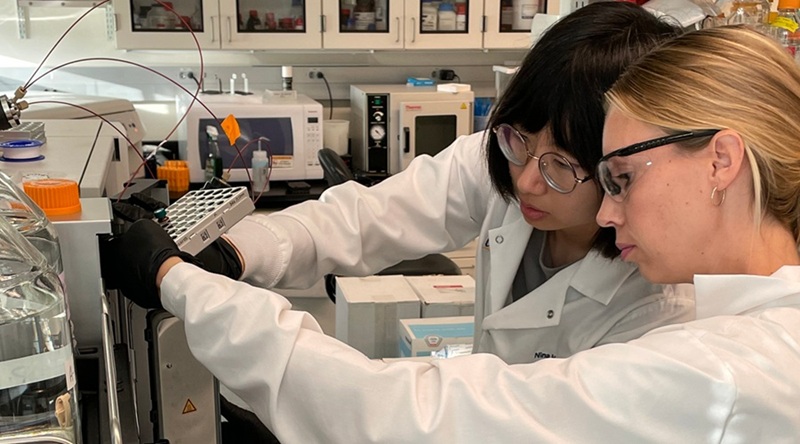Prognostic Value of Specific Biomarker in Prostate Cancer Authenticated
|
By LabMedica International staff writers Posted on 20 Aug 2019 |

Image: The VS110 combines microscopy seamlessly with imaging to create a virtual slide that is an exact copy of the real specimen (Photo courtesy of Olympus).
Prostate cancer (PC) is the most commonly diagnosed cancer in Canadian men. In men with high-risk PC, progression of the disease will lead to biochemical recurrence (BCR), distant metastases, and disease-specific mortality.
The extensively studied nuclear factor kappa B (NF-κB) pathway is involved in the regulation of inflammation and the immune response, and more recently demonstrated its importance in cancer development. The activation of the NF-κB signaling pathways can result in the progression of several types of cancer, including PC.
A large team of scientists at the Centre hospitalier de l’Université de Montréal (Montreal, QC, Canada) and their associates accessed two different multi-center tissue microarrays (TMAs) representing cohorts of patients (Test-TMA and Validation-TMA series) of the Canadian Prostate Cancer Biomarker Network (CPCBN) to validate the association between p65 nuclear frequency and PC outcomes. Immunohistochemical staining of p65 was performed on the Test-TMA and Validation-TMA series, which include PC tissues from patients treated by first-line radical prostatectomy (n = 250 and n = 1,262, respectively).
For each patient, 0.6-mm cores (3–4 of tumor tissue and 1–2 of benign adjacent tissue) were punctured from formalin-fixed paraffin-embedded blocks and transferred to receiver blocks. Four-micrometer-thick sections of each TMA block were subjected to antigen retrieval in Cell Conditioning 1 for 90 minutes and then stained using the BenchMark XT autostainer. All sections were scanned using a VS-110 microscope with a 20× 0.75 NA objective and a resolution of 0.3225 μm. Two independent observers evaluated the p65 nuclear frequency in digital images of cancer tissue and benign adjacent gland tissue.
Multivariate analysis of the Validation-TMA cohort showed that p65 nuclear frequency in cancer cells was an independent predictor of BCR using continuous (hazard ratio [HR] 1.02) and dichotomized data (HR 1.33). The team used a cutoff of 3%, and found that this biomarker was also associated with the development of bone metastases (HR 1.82) and PC-specific mortality (HR 2.63), independent of clinical parameters. BCR-free survival, bone-metastasis-free survival, and PC-specific survival were shorter for patients with higher p65 nuclear frequency.
The authors concluded that they had demonstrated the prognostic significance of nuclear p65 in two independent PC TMA cohorts that included primary tumor tissues of patients from multiple institutions. The implementation of this biomarker in the clinical workflow would allow genitourinary pathologists and clinicians to improve the identification of patients with high-risk PC. The study was published on July 2, 2019, in the journal PLOS Medicine.
Related Links:
Centre hospitalier de l’Université de Montréal
The extensively studied nuclear factor kappa B (NF-κB) pathway is involved in the regulation of inflammation and the immune response, and more recently demonstrated its importance in cancer development. The activation of the NF-κB signaling pathways can result in the progression of several types of cancer, including PC.
A large team of scientists at the Centre hospitalier de l’Université de Montréal (Montreal, QC, Canada) and their associates accessed two different multi-center tissue microarrays (TMAs) representing cohorts of patients (Test-TMA and Validation-TMA series) of the Canadian Prostate Cancer Biomarker Network (CPCBN) to validate the association between p65 nuclear frequency and PC outcomes. Immunohistochemical staining of p65 was performed on the Test-TMA and Validation-TMA series, which include PC tissues from patients treated by first-line radical prostatectomy (n = 250 and n = 1,262, respectively).
For each patient, 0.6-mm cores (3–4 of tumor tissue and 1–2 of benign adjacent tissue) were punctured from formalin-fixed paraffin-embedded blocks and transferred to receiver blocks. Four-micrometer-thick sections of each TMA block were subjected to antigen retrieval in Cell Conditioning 1 for 90 minutes and then stained using the BenchMark XT autostainer. All sections were scanned using a VS-110 microscope with a 20× 0.75 NA objective and a resolution of 0.3225 μm. Two independent observers evaluated the p65 nuclear frequency in digital images of cancer tissue and benign adjacent gland tissue.
Multivariate analysis of the Validation-TMA cohort showed that p65 nuclear frequency in cancer cells was an independent predictor of BCR using continuous (hazard ratio [HR] 1.02) and dichotomized data (HR 1.33). The team used a cutoff of 3%, and found that this biomarker was also associated with the development of bone metastases (HR 1.82) and PC-specific mortality (HR 2.63), independent of clinical parameters. BCR-free survival, bone-metastasis-free survival, and PC-specific survival were shorter for patients with higher p65 nuclear frequency.
The authors concluded that they had demonstrated the prognostic significance of nuclear p65 in two independent PC TMA cohorts that included primary tumor tissues of patients from multiple institutions. The implementation of this biomarker in the clinical workflow would allow genitourinary pathologists and clinicians to improve the identification of patients with high-risk PC. The study was published on July 2, 2019, in the journal PLOS Medicine.
Related Links:
Centre hospitalier de l’Université de Montréal
Latest Pathology News
- Rapid Low-Cost Tests Can Prevent Child Deaths from Contaminated Medicinal Syrups
- Tumor Signals in Saliva and Blood Enable Non-Invasive Monitoring of Head and Neck Cancer
- Common Health Issues Can Influence New Blood Tests for Alzheimer’s Disease
- Blood Test Formula Identifies Chronic Liver Disease Patients with Higher Cancer Risk
- Tunable Cell-Sorting Device Holds Potential for Multiple Biomedical Applications
- AI Tool Outperforms Doctors in Spotting Blood Cell Abnormalities
- AI Tool Rapidly Analyzes Complex Cancer Images for Personalized Treatment
- Diagnostic Technology Performs Rapid Biofluid Analysis Using Single Droplet
- Novel Technology Tracks Hidden Cancer Cells Faster
- AI Tool Improves Breast Cancer Detection
- AI Tool Predicts Treatment Success in Rectal Cancer Patients
- Blood Test and Sputum Analysis Predict Acute COPD Exacerbation
- AI Tool to Transform Skin Cancer Detection with Near-Perfect Accuracy
- Unique Immune Signatures Distinguish Rare Autoimmune Condition from Multiple Sclerosis
- Simple Optical Microscopy Method Reveals Hidden Structures in Remarkable Detail
- Hydrogel-Based Technology Isolates Extracellular Vesicles for Early Disease Diagnosis
Channels
Clinical Chemistry
view channel
Online Tool Detects Drug Exposure Directly from Patient Samples
Doctors often rely on patient interviews and medical records to determine what medications a person has taken, but this information is frequently incomplete. People may forget drugs they used, take over-the-counter... Read more
Chemical Imaging Probe Could Track and Treat Prostate Cancer
Prostate cancer remains a leading cause of illness and death among men, with many patients eventually developing resistance to standard hormone-blocking therapies. These drugs often lose effectiveness... Read moreMolecular Diagnostics
view channel
New 15-Minute Hepatitis C Test Paves Way for Same-Day Treatment
Chronic hepatitis C infection affects an estimated 50 million people worldwide and causes around 242,000 deaths each year, largely due to cirrhosis and liver cancer. Although the infection is curable with... Read more
Ovarian Cancer Assay Outperforms Traditional Tests in Early Disease Detection
Globally, ovarian cancer is one of the deadliest cancers affecting women. Traditionally, early diagnosis of ovarian cancer has been challenging. Many ovarian cancers are diagnosed only after they have... Read moreHematology
view channel
MRD Tests Could Predict Survival in Leukemia Patients
Acute myeloid leukemia is an aggressive blood cancer that disrupts normal blood cell production and often relapses even after intensive treatment. Clinicians currently lack early, reliable markers to predict... Read more
Platelet Activity Blood Test in Middle Age Could Identify Early Alzheimer’s Risk
Early detection of Alzheimer’s disease remains one of the biggest unmet needs in neurology, particularly because the biological changes underlying the disorder begin decades before memory symptoms appear.... Read more
Microvesicles Measurement Could Detect Vascular Injury in Sickle Cell Disease Patients
Assessing disease severity in sickle cell disease (SCD) remains challenging, especially when trying to predict hemolysis, vascular injury, and risk of complications such as vaso-occlusive crises.... Read more
ADLM’s New Coagulation Testing Guidance to Improve Care for Patients on Blood Thinners
Direct oral anticoagulants (DOACs) are one of the most common types of blood thinners. Patients take them to prevent a host of complications that could arise from blood clotting, including stroke, deep... Read moreImmunology
view channel
Routine Blood Test Can Predict Who Benefits Most from CAR T-Cell Therapy
CAR T-cell therapy has transformed treatment for patients with relapsed or treatment-resistant non-Hodgkin lymphoma, but many patients eventually relapse despite an initial response. Clinicians currently... Read more
New Test Distinguishes Vaccine-Induced False Positives from Active HIV Infection
Since HIV was identified in 1983, more than 91 million people have contracted the virus, and over 44 million have died from related causes. Today, nearly 40 million individuals worldwide live with HIV-1,... Read more
Gene Signature Test Predicts Response to Key Breast Cancer Treatment
DK4/6 inhibitors paired with hormone therapy have become a cornerstone treatment for advanced HR+/HER2– breast cancer, slowing tumor growth by blocking key proteins that drive cell division.... Read more
Chip Captures Cancer Cells from Blood to Help Select Right Breast Cancer Treatment
Ductal carcinoma in situ (DCIS) accounts for about a quarter of all breast cancer cases and generally carries a good prognosis. This non-invasive form of the disease may or may not become life-threatening.... Read moreMicrobiology
view channel
Blood-Based Diagnostic Method Could Identify Pediatric LRTIs
Lower-respiratory tract infections (LRTIs) are a leading cause of illness and death worldwide, and pneumonia is the leading infectious cause of death in children under five, claiming the lives of over... Read more
Rapid Diagnostic Test Matches Gold Standard for Sepsis Detection
Sepsis kills 11 million people worldwide every year and generates massive healthcare costs. In the USA and Europe alone, sepsis accounts for USD 100 billion in annual hospitalization expenses.... Read moreRapid POC Tuberculosis Test Provides Results Within 15 Minutes
Tuberculosis remains one of the world’s deadliest infectious diseases, and reducing new cases depends on identifying individuals with latent infection before it progresses. Current diagnostic tools often... Read more
Rapid Assay Identifies Bloodstream Infection Pathogens Directly from Patient Samples
Bloodstream infections in sepsis progress quickly and demand rapid, precise diagnosis. Current blood-culture methods often take one to five days to identify the pathogen, leaving clinicians to treat blindly... Read moreTechnology
view channel
Machine Learning Models Diagnose ALS Earlier Through Blood Biomarkers
Amyotrophic lateral sclerosis (ALS) is a rapidly progressive neurodegenerative disease that is notoriously difficult to diagnose in its early stages. Early symptoms often overlap with other neurological... Read more
Artificial Intelligence Model Could Accelerate Rare Disease Diagnosis
Identifying which genetic variants actually cause disease remains one of the biggest challenges in genomic medicine. Each person carries tens of thousands of DNA changes, yet only a few meaningfully alter... Read moreIndustry
view channel
Abbott Acquires Cancer-Screening Company Exact Sciences
Abbott (Abbott Park, IL, USA) has entered into a definitive agreement to acquire Exact Sciences (Madison, WI, USA), enabling it to enter and lead in fast-growing cancer diagnostics segments.... Read more



















